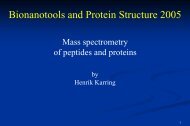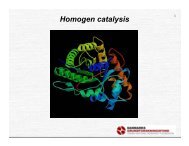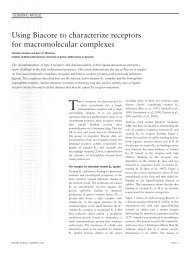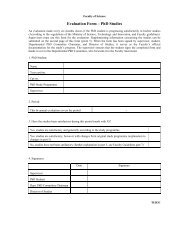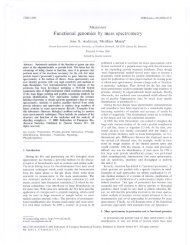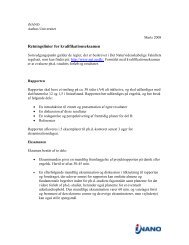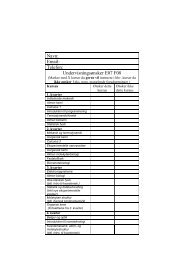Characterization of the human cornea proteome with reference to ...
Characterization of the human cornea proteome with reference to ...
Characterization of the human cornea proteome with reference to ...
You also want an ePaper? Increase the reach of your titles
YUMPU automatically turns print PDFs into web optimized ePapers that Google loves.
<strong>Characterization</strong> <strong>of</strong> <strong>the</strong> <strong>human</strong><br />
<strong>cornea</strong> <strong>proteome</strong> <strong>with</strong> <strong>reference</strong> <strong>to</strong><br />
ocular transparency<br />
by<br />
Henrik Karring<br />
Department <strong>of</strong> Molecular Biology, Aarhus
The eye<br />
Lens<br />
Retina<br />
Pupil<br />
Cornea<br />
Optic nerve<br />
Iris<br />
Sclera<br />
Vitreous humor
The <strong>cornea</strong><br />
Pupil<br />
Cornea<br />
Iris<br />
Cornea<br />
Sclera
The <strong>cornea</strong>l stroma<br />
epi<strong>the</strong>lium<br />
Collagen<br />
lamellae<br />
Quiescent and<br />
transparent<br />
kera<strong>to</strong>cytes<br />
stroma<br />
~ 450 μm<br />
endo<strong>the</strong>lium
Transparency <strong>of</strong> <strong>the</strong> extracellular matrix<br />
Collagen lamellae<br />
kera<strong>to</strong>cyte<br />
Collagen fibers<br />
Hexagonal oriented array<br />
~30 nm diameter<br />
~60 nm regular spacing
Proteome analysis <strong>of</strong> <strong>the</strong><br />
<strong>human</strong> <strong>cornea</strong>
Materials<br />
• 16 normal <strong>human</strong> donor <strong>cornea</strong>s<br />
• Age 22-86 years<br />
• Containing all cell-layers<br />
• Lyophilized and homogenized in N 2<br />
• Fine <strong>cornea</strong>l powder
Extraction pro<strong>to</strong>cols 1 and 2<br />
• Proteins were extracted in urea or 100 mM NaCl<br />
• Separated by 2D gel electrophoresis<br />
• Proteins identified by MALDI-TOF MS
Peptide mass fingerprinting by<br />
MALDI-MS<br />
Trypsin<br />
digestion<br />
Abundance<br />
p5<br />
p3<br />
p1<br />
p4<br />
p2<br />
MALDI-MS<br />
Peptide<br />
extraction<br />
and matrix<br />
MALDI target<br />
m/z
Extraction pro<strong>to</strong>col 3<br />
• The <strong>cornea</strong>l powder was solubilized using<br />
CNBr and trypsin<br />
• The peptides were separated by <strong>of</strong>f-line strong<br />
cation exchange and identified using LC-<br />
MS/MS
Corneal<br />
powder<br />
CNBr and<br />
trypsin<br />
Abundance<br />
LC-MS/MS<br />
m/z<br />
Strong cation<br />
exchange<br />
App. 30 pools
Extraction pro<strong>to</strong>col 4<br />
• Proteins were extracted in SDS sample buffer<br />
and separated by SDS-PAGE<br />
• The gel lane was sliced in ~2-mm strips and<br />
digested <strong>with</strong> trypsin<br />
• The extracted peptides were identified by LC-<br />
MS/MS
Mw<br />
(kDa)<br />
200<br />
116<br />
97<br />
66<br />
45<br />
31<br />
22<br />
14<br />
6<br />
35 slices<br />
trypsin<br />
Abundance<br />
LC-MS/MS<br />
m/z
Results<br />
• Urea, 2D-gels, MALDI-TOF MS:<br />
• CNBr-trypsin, SCX, LC-MS/MS: 31<br />
• SDS-PAGE slices, LC-MS/MS: 103<br />
Identified<br />
proteins<br />
67 (165 spots)<br />
Total number <strong>of</strong> different proteins: 141<br />
Karring H. et al., MCP, 2005
Tissue distribution<br />
38%<br />
60%<br />
Karring H. et al., MCP, 2005
Functional groups<br />
Extracellular<br />
Intracellular<br />
39%<br />
27% 24% 28%<br />
17%<br />
Karring H. et al., MCP, 2005
Comparison <strong>of</strong> protein and gene<br />
expression in <strong>the</strong> <strong>cornea</strong><br />
61% <strong>of</strong> <strong>the</strong> identified proteins were recognized<br />
in <strong>the</strong> NEIBank gene expression libraries<br />
Structural proteins: 64%<br />
Blood/plasma proteins: 14%<br />
Metabolic proteins: 75%<br />
Immune defence proteins: 40%<br />
Redox proteins: 100%<br />
Folding and degradation: 100%<br />
O<strong>the</strong>r functions: 62%
Conclusions<br />
• 99 (70%) <strong>of</strong> <strong>the</strong> 141 identified proteins have<br />
not previously been identified in <strong>the</strong> <strong>cornea</strong>.<br />
• A significant number <strong>of</strong> protein is<strong>of</strong>orms were<br />
identified (albumin, Ig-kappa chain, TGFBIp).<br />
• Only 14% <strong>of</strong> <strong>the</strong> plasma proteins were<br />
recognized in gene expression libraries.<br />
• First part <strong>of</strong> a protein <strong>reference</strong> library for<br />
targeted studies <strong>of</strong> <strong>cornea</strong>l diseases.
Corneal TGFBIp dystrophy<br />
Normal<br />
Dystrophy
2D gels and proteomics<br />
Normal<br />
Dystrophy<br />
Hedegaard C. et al., MolVis, 2003
Proteomic analysis <strong>of</strong> <strong>the</strong><br />
soluble fraction from cultured<br />
<strong>human</strong> <strong>cornea</strong>l fibroblasts
Corneal wound-healing<br />
Hazy <strong>cornea</strong>l<br />
fibroblasts<br />
Apop<strong>to</strong>sis<br />
Proliferation<br />
and migration
Near-sightedness (Myopia)
Excimer laser<br />
2<br />
keratec<strong>to</strong>my<br />
(LASIK)<br />
Flap<br />
1<br />
3
Cellular haze after eximer laser<br />
keratec<strong>to</strong>my<br />
Normal<br />
Hazy<br />
Møller-Pedersen T. 2004
Cellular transparency<br />
• Abundant cy<strong>to</strong>plasmic water-soluble proteins (5-40%)<br />
• Normally metabolic enzymes – enzyme-crystallins<br />
• Taxon-specific in vertebrates and invertebrates<br />
(E.g. aldehyde dehydrogenase 3 or 1, and transke<strong>to</strong>lase)<br />
• May regulate <strong>the</strong> refractive index <strong>of</strong> <strong>the</strong> cy<strong>to</strong>plasm ?<br />
backscattering<br />
Knockout mice<br />
have normal<br />
<strong>cornea</strong>s
Cell culturing (Explant)<br />
10 % FBS<br />
Proteomics <strong>of</strong><br />
soluble fraction<br />
Isolate and<br />
lyse cells
No enzyme-crystallins in<br />
<strong>cornea</strong>l fibroblasts<br />
Vimentin (51 kDa is<strong>of</strong>orm) 1.1 +/-0.1%<br />
Vimentin (59 kDa is<strong>of</strong>orm) 1.5 +/-0.1%<br />
Actin 2.1 +/-0.2%<br />
Annexin A2 1.0 +/-0.2%<br />
All < 5%<br />
No enzyme-crystallins<br />
Karring H. et al., MCP, 2004
M r /kDa<br />
pH<br />
4.5 5.5<br />
64<br />
41<br />
78<br />
90<br />
5<br />
13<br />
77<br />
52<br />
72<br />
110<br />
111<br />
5.0 5.25<br />
60<br />
39<br />
134<br />
133<br />
58<br />
130<br />
127<br />
128<br />
51<br />
123<br />
122<br />
34<br />
48<br />
22<br />
21<br />
24<br />
120<br />
108<br />
119<br />
26<br />
35<br />
36<br />
135<br />
136<br />
137<br />
141<br />
142<br />
102<br />
146<br />
147<br />
149 150 151<br />
152<br />
153<br />
154<br />
155<br />
66<br />
157<br />
158<br />
159<br />
9-11<br />
8<br />
162<br />
7<br />
163 164 4<br />
166<br />
83<br />
176<br />
96<br />
29<br />
62<br />
99<br />
182 171<br />
170<br />
76<br />
14<br />
15<br />
16<br />
17<br />
174<br />
183<br />
184<br />
185<br />
186<br />
187<br />
173<br />
189<br />
192<br />
193<br />
194<br />
195<br />
196<br />
50<br />
198<br />
199<br />
201<br />
202<br />
204<br />
88<br />
31.0<br />
21.0<br />
14.4<br />
45.0<br />
66.2<br />
94.4<br />
4.75
Peptide mass fingerprinting or<br />
MALDI-MS/MS<br />
Protein Acc. # Function and FL aa /M th /pI th Gel ID. Spot ID. Covered fragment<br />
localization<br />
Actin, beta or gamma<br />
P02570 or<br />
P02571<br />
C/c 375/41.7/5.3 A/C<br />
A/C<br />
A/C<br />
A/C<br />
A<br />
A<br />
A<br />
C<br />
C<br />
C<br />
C<br />
C<br />
C<br />
14<br />
15<br />
16<br />
17<br />
25<br />
83<br />
114<br />
152<br />
153<br />
176<br />
186<br />
198<br />
199<br />
A19-K373<br />
A29-K373<br />
A19-K373<br />
A29-K373<br />
A19-K373<br />
V96-R372<br />
A29-K373<br />
A19-K336<br />
A19-K336<br />
G63-K373<br />
V96-R372<br />
I85-K336<br />
I85-K336<br />
Acyl-CoA-binding protein P07108 M/c/n 87/9.9/6.1 D 216 S2-K67<br />
Alcohol dehydrogenase [NADP + ] (Aldo-ke<strong>to</strong> reductase P14550 M/c 325/36.8/6.3 D 145 M14-K308<br />
1A1)<br />
Alpha-actinin 1 P12814 C/c 892/103.5/5.2 A 66 I656-R863<br />
Annexin A1 P04083 P/L/T/c/a/n 346/38.8/6.6 A<br />
A<br />
B<br />
Annexin A2 P07355 P/L/T/c/a 339/38.7/7.6 A<br />
A<br />
D<br />
C<br />
34<br />
48<br />
218<br />
53<br />
95<br />
121<br />
141<br />
Q10-R228<br />
G30-R228<br />
Q10-R228<br />
L11-R168<br />
A29-R205<br />
L11-R245<br />
L11-R168<br />
Annexin V P08758 P/L/T/c/a 320/35.8/5.0 A 75 G7-R285<br />
ATP synthase alpha chain, mi<strong>to</strong>chondrial precursor P25705 M/m 553/59.8/9.2 C 157 T46-K194<br />
ATP synthase beta chain, mi<strong>to</strong>chondrial precursor P06576 M/m 529/56.5/5.3 A/C 4 L95-K480<br />
ATP synthase D chain, mi<strong>to</strong>chondrial precursor O75947 M/m 161/18.5/5.2 C 120 T10-K121<br />
Beta-2-microglobulin, precursor P01884 I/s 119/13.8/6.1 D 230 V102-K111<br />
Calcyclin (S100A6) P06703 P/F/L/r/n 90/10.2/5.3 C<br />
C<br />
133<br />
134<br />
E41-R55<br />
E41-R55<br />
Calgizzarin (S100A14 or S100A11p) NP_066369 U/u 102/11.4/7.8 A 61 I4-K78<br />
Calmodulin P02593 L/S/P/c 149/16.8/4.1 A 49 E15-K149<br />
Calreticulin, precursor P27797 F/S/e 417/48.3/4.3 A 74 E25-K286<br />
Karring H. et al., MCP, 2004
Proteomic data<br />
• 254 spots identified by MALDI-MS or MS/MS<br />
• 118 distinct proteins<br />
• 1 hypo<strong>the</strong>tical protein<br />
“bone marrow stroma-derived growth fac<strong>to</strong>r”<br />
• 5 proteins classified as enzyme-crystallins in various species<br />
α-enolase<br />
non-filamen<strong>to</strong>us actin<br />
isocitrate dehydrogenase<br />
glutathione-S-transferase<br />
peptidyl prolyl cis-trans isomerase A
Protein folding and degradation: 32<br />
Cell proliferation, differentiation, and apop<strong>to</strong>sis: 24<br />
Metabolism: 23<br />
Cy<strong>to</strong>skele<strong>to</strong>n organisation and cell motility: 21<br />
Redox regulation and oxidative stress defence: 17<br />
Signal transduction: 13<br />
Secre<strong>to</strong>ry pathway: 11<br />
Indicate that oxidative stress and protein misfolding<br />
may participate in <strong>the</strong> backscattering <strong>of</strong> light from<br />
<strong>cornea</strong>l fibroblasts
Protein denaturation<br />
Fried egg<br />
Cataract<br />
Denaturation and precipitation <strong>of</strong> proteins means<br />
scatter <strong>of</strong> light and loss <strong>of</strong> transparency.
Model <strong>of</strong> <strong>cornea</strong>l cellular haze<br />
Irreversible oxidation<br />
Unfolding<br />
Reactive oxygen species (ROS)<br />
High molecular<br />
weight aggregates<br />
Protein degradation
Acknowledgements<br />
Department <strong>of</strong> Molecular Biology<br />
Aarhus University<br />
Jan J. Enghild, PhD, Associate Pr<strong>of</strong>essor<br />
Ida B. Thøgersen, Technician<br />
Department <strong>of</strong> Ophthalmology<br />
Aarhus University Hospital<br />
Torben Møller-Pedersen, MD, DMSc<br />
Foundations<br />
Danish Medical Research Council<br />
The Danish Association for Prevention<br />
<strong>of</strong> Eye Diseases and Blindness<br />
The Novo Nordic Foundation<br />
The Synoptik Foundation<br />
National Institute <strong>of</strong> Health<br />
Duke University Medical Center,<br />
North Carolina<br />
Gordon K. Klintworth, Pr<strong>of</strong>essor



